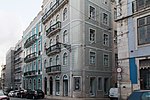Mercês (Lisbon)
Former parishes of LisbonLisbon geography stubs
Mercês is a former parish (freguesia) in the municipality of Lisbon, Portugal. At the administrative reorganization of Lisbon on 8 December 2012 it became part of the parish Misericórdia. It has a total area of 0.30 km2 and total population of 5,093 inhabitants (2001); density: 16,808.6 inhabitants/km2.
Excerpt from the Wikipedia article Mercês (Lisbon) (License: CC BY-SA 3.0, Authors).Mercês (Lisbon)
Rua da Misericórdia, Lisbon Bairro Alto (Misericórdia)
Geographical coordinates (GPS) Address Nearby Places Show on map
Geographical coordinates (GPS)
| Latitude | Longitude |
|---|---|
| N 38.7125 ° | E -9.14306 ° |
Address
Largo Trindade Coelho
Rua da Misericórdia
1200-270 Lisbon, Bairro Alto (Misericórdia)
Portugal
Open on Google Maps









